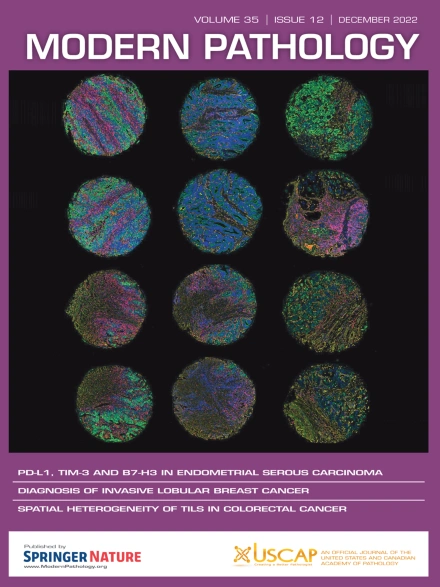人表皮生长因子受体2 -超低值乳腺癌的发病率、临床病理特征及随访结果
IF 5.5
1区 医学
Q1 PATHOLOGY
引用次数: 0
摘要
fate - breast06试验的初步结果证明了抗体-药物偶联治疗人表皮生长因子受体-2 (HER2) -超低乳腺癌(BC)患者的有效性,其定义是存在≤10%的浸润性癌细胞,在HER2免疫组织化学上显示不完全和微弱/弱的膜染色。在这项研究中,我们研究了her2 -超低、her2 -零和her2 -低表达患者的病理特征和临床结果。HER2超低发生率为17.5%(260/1486)。其他组HER2无发生率为7.7%,HER2低发生率为56.8%,HER2阳性发生率为18%。her2超低病例与her2低病例相似,但与her2无病例有显著差异,包括年龄较大(61.1岁vs 57.3岁;P = 0.0099), 3级bc较少(18.1% vs 53.9%;P & lt;0.0001),三阴性bc (16.2% vs 42.6%;P & lt;0.0001),雌激素受体(ER)阴性bc (16.5% vs 47.8%;P & lt;0.0001),孕激素受体阴性的bc (26.2% vs 54.8%;P & lt;。)。当病例根据ER阳性进行分层时,HER2-null组和her2 -超低组之间的差异仅限于ER阳性病例,而不包括ER阴性病例。her2阴性、her2超低和her2低的bc对新辅助化疗的反应没有明显差异(n = 125)。HER2-null/ER - bc的总生存率低于her2 -超低和her2 -低/ER - bc,但3组间无病生存率无统计学差异。her2 -超低的红细胞比her2 -无的红细胞更接近her2 -低的红细胞。这些发现有助于研究BC中HER2表达的分类,并可能对改进该亚组的治疗策略具有指导意义。本文章由计算机程序翻译,如有差异,请以英文原文为准。
Incidence, Clinicopathologic Features, and Follow-Up Results of human epidermal growth factor receptor-2–Ultralow Breast Carcinoma
The preliminary result of DESTINY-Breast06 trial demonstrated the effectiveness of antibody-drug conjugate in patients with human epidermal growth factor receptor-2 (HER2)–ultralow breast carcinoma (BC), defined by the presence of ≤10% of infiltrating cancer cells showing incomplete and faint/weak membrane staining on HER2 immunohistochemistry. In this study, we investigated the pathologic features and clinical outcomes in patients with HER2-ultralow, HER2-null, and HER2-low expression. The incidence of HER2 ultralow was 17.5% (260/1486). The incidence of other groups is as follows: 7.7% for HER2 null, 56.8% for HER2 low, and 18% for HER2 positive. HER2-ultralow cases showed similarity to HER2-low cases but a significant difference from HER2-null cases, including older age (61.1 vs 57.3 years; P = .0099), fewer grade 3 BCs (18.1% vs 53.9%; P < .0001), triple-negative BCs (16.2% vs 42.6%; P < .0001), estrogen receptor (ER)–negative BCs (16.5% vs 47.8%; P < .0001), and progesterone receptor–negative BCs (26.2% vs 54.8%; P < .0001). When cases were stratified based on ER positivity, these differences between HER2-null and HER2-ultralow groups were confined to ER+ but not ER− cases. There were no discernible differences in response to neoadjuvant chemotherapy (n = 125) among HER2-null, HER2-ultralow, and HER2-low BCs. HER2-null/ER−BCs displayed a lower probability of overall survival than HER2-ultralow and HER2-low/ER−BCs, but no statistically significant difference was observed in disease-free survival among the 3 groups. HER2-ultralow BCs exhibit distinct features that align more closely with HER2-low BCs than HER2-null BCs. These findings contribute to the evolving classification of HER2 expression in BC and may have implications for refining treatment strategies in this subgroup.
求助全文
通过发布文献求助,成功后即可免费获取论文全文。
去求助
来源期刊

Modern Pathology
医学-病理学
CiteScore
14.30
自引率
2.70%
发文量
174
审稿时长
18 days
期刊介绍:
Modern Pathology, an international journal under the ownership of The United States & Canadian Academy of Pathology (USCAP), serves as an authoritative platform for publishing top-tier clinical and translational research studies in pathology.
Original manuscripts are the primary focus of Modern Pathology, complemented by impactful editorials, reviews, and practice guidelines covering all facets of precision diagnostics in human pathology. The journal's scope includes advancements in molecular diagnostics and genomic classifications of diseases, breakthroughs in immune-oncology, computational science, applied bioinformatics, and digital pathology.
 求助内容:
求助内容: 应助结果提醒方式:
应助结果提醒方式:


